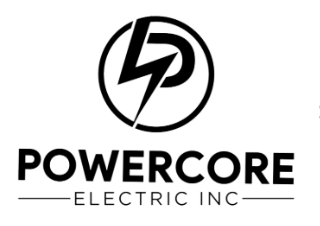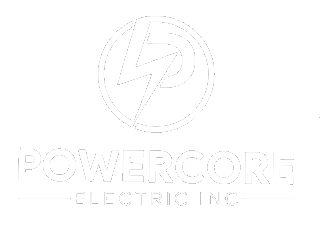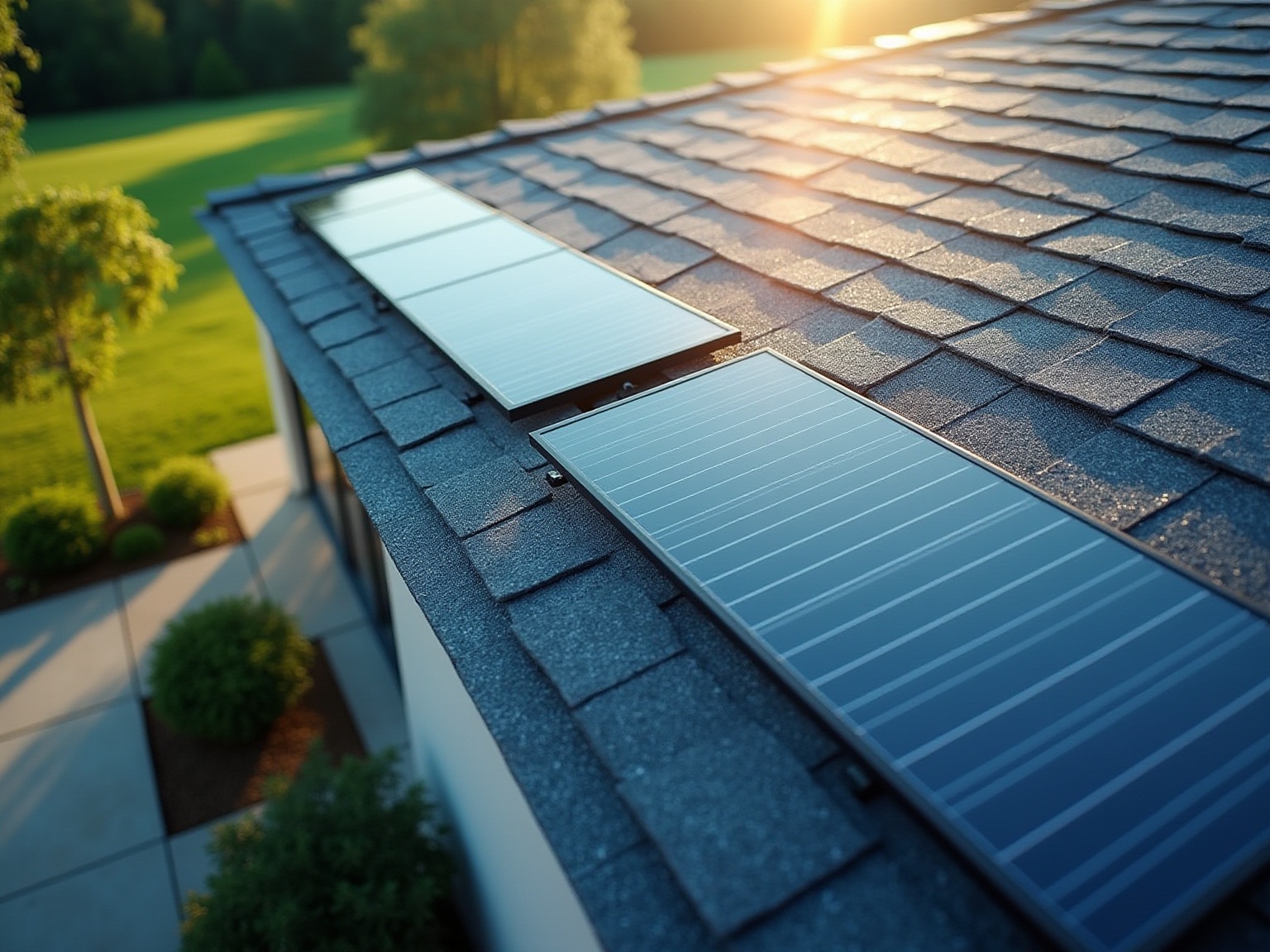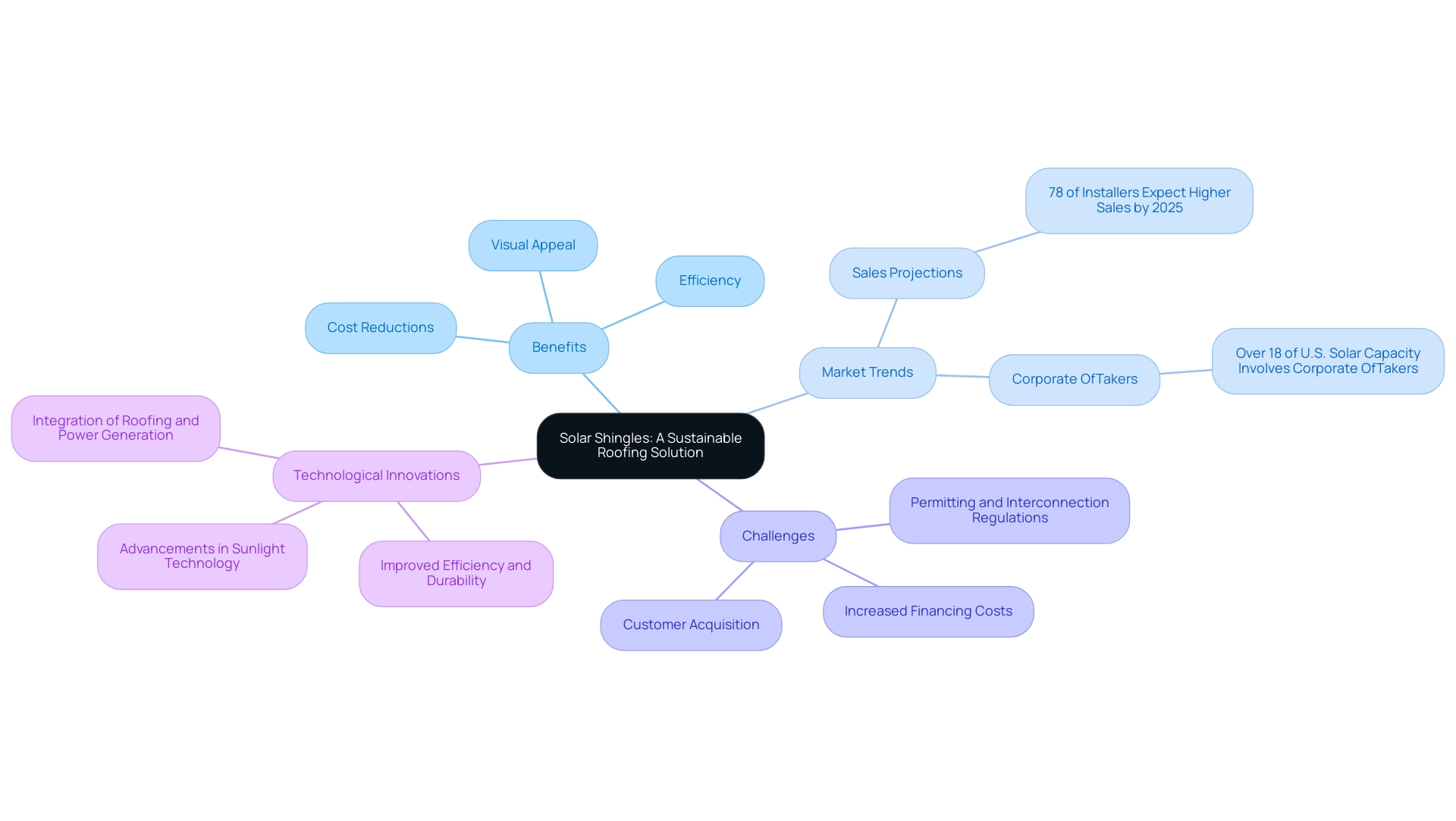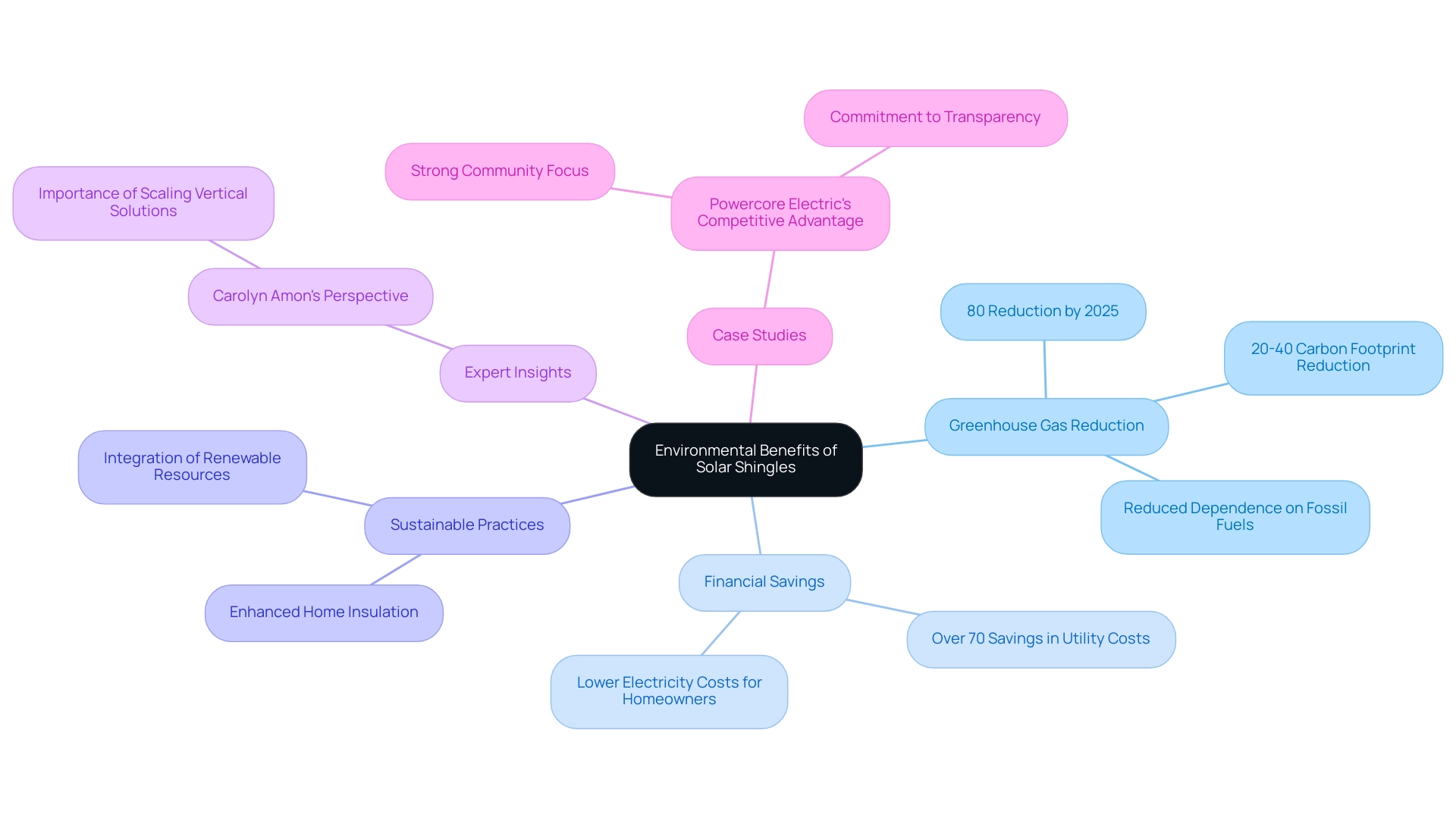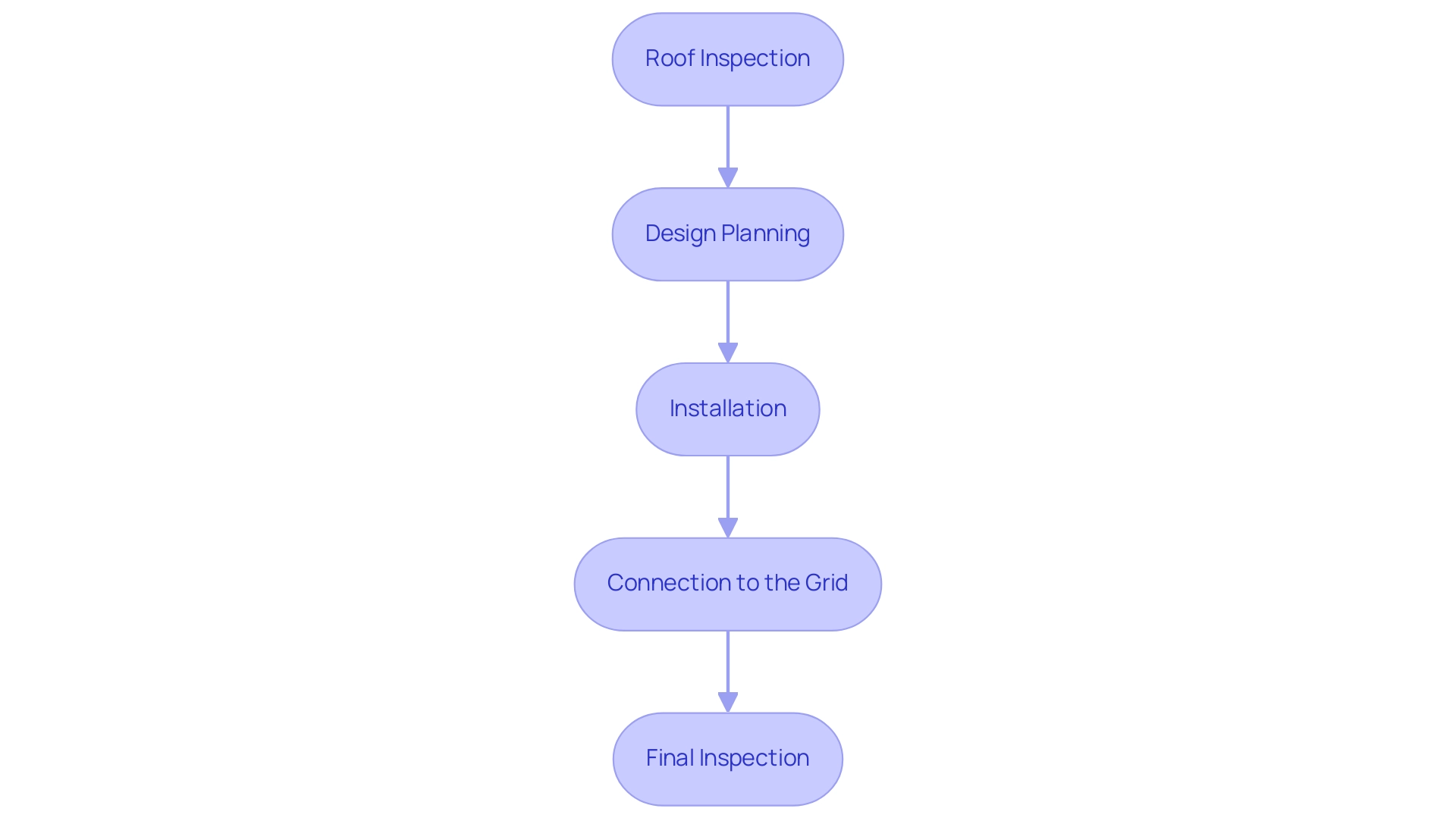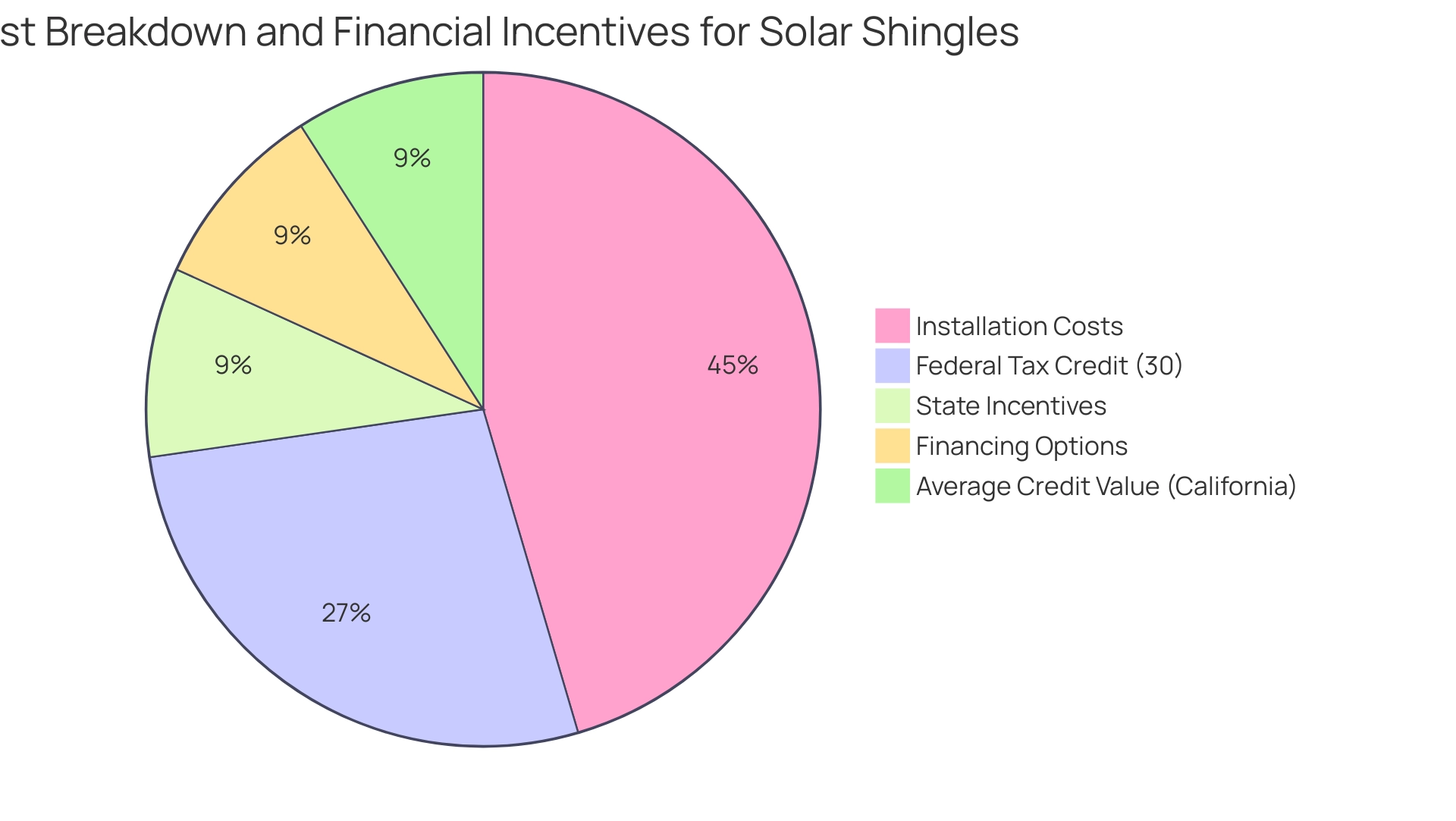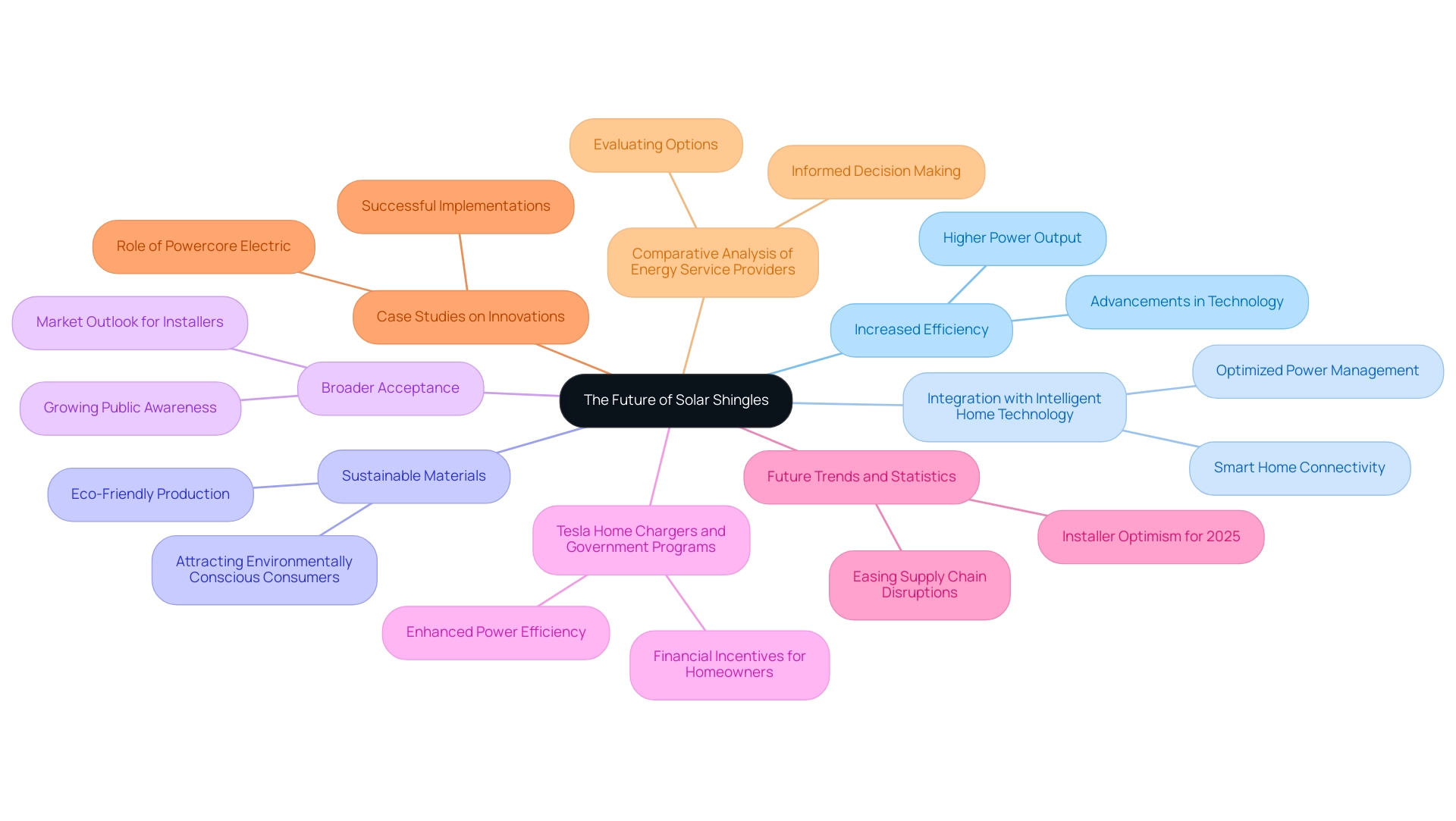Overview
In 2025, many eco-conscious homeowners find themselves concerned about rising energy bills and the impact of their choices on the environment. The article highlights the top seven solar shingle products that not only address these concerns but also pave the way for a more sustainable future. These innovative shingles enhance energy efficiency and significantly reduce costs, allowing homeowners to take control of their energy needs. As we embrace these advancements in photovoltaic roofing, we can see the growing market for such solutions, reflecting a collective shift towards sustainability.
It’s common to feel overwhelmed by the options available, but rest assured, these solar shingles represent a meaningful step towards energy independence. By adopting this technology, homeowners are not just cutting down on expenses; they are actively contributing to a greener planet. The increasing adoption rates and technological advancements within the renewable energy sector are a testament to this positive change.
Together, we can make informed decisions that benefit both our homes and the environment. If you’re ready to explore these solar shingle options and join the movement towards sustainability, let’s work towards a brighter, more energy-efficient future together.
Introduction
As we navigate the shift towards sustainable energy solutions, many homeowners are understandably concerned about rising energy bills and the impact on their finances. Solar shingles present a revolutionary option that not only addresses these concerns but also enhances the aesthetic appeal of your home. Unlike traditional solar panels, these innovative roofing materials integrate seamlessly into your home’s structure, generating electricity while elevating its overall look.
With the solar shingles market projected to experience significant growth in the coming years, it’s important to explore their myriad benefits. From boosting energy efficiency to increasing property value, solar shingles offer a pathway to energy independence that many eco-conscious homeowners desire. We understand that making the switch to renewable energy can feel daunting, but this article delves into the challenges the solar industry faces, expert insights on future trends, and practical considerations for those contemplating this eco-friendly upgrade.
As the demand for renewable energy solutions rises, understanding solar shingles becomes essential for anyone looking to embrace a more sustainable lifestyle. Together, we can work towards a greener future, ensuring that your home not only meets your energy needs but also reflects your commitment to the environment. Let’s explore how solar shingles can transform your home into a beacon of sustainability.
Understanding Solar Shingles: A Sustainable Roofing Solution
As homeowners, we often worry about rising energy bills and the impact they have on our budgets. Solar tiles represent a groundbreaking advancement in roofing technology, seamlessly integrating photovoltaic cells to generate electricity while serving as a roof. Unlike conventional panels that are placed on top of existing roofs, photovoltaic tiles replace standard roofing materials, offering a stylish and attractive solution. Designed to mimic the look of traditional roofing materials, they cater to those who value both aesthetics and practicality.
This innovative approach not only enhances a home’s efficiency but also elevates its overall market value and visual appeal, ultimately aiding in cost reductions and promoting an environmentally friendly lifestyle. We understand that making such a significant change can feel daunting, but the benefits are profound.
Looking ahead, the market for photovoltaic roofing is expected to witness substantial growth by 2025. Data indicates that 78% of installers anticipate higher sales in renewable technologies. This trend reflects a broader shift towards sustainable power solutions, with over 18% of U.S. photovoltaic capacity now involving corporate offtakers. Companies are diversifying their procurement strategies through on-site and off-site installations, community systems, and renewable plus storage options. Such diversification not only supports job creation but also promotes fair access to renewable resources, including initiatives like the Biden-Harris administration’s $7 billion Solar for All program, designed to enhance access to clean power for diverse communities.
However, it’s common to feel apprehensive about the challenges that the photovoltaic sector faces, such as permitting and interconnection regulations, customer acquisition, and increased financing costs. These barriers are recognized as significant obstacles for renewable energy firms, but they are not insurmountable.
Experts emphasize the feasibility of photovoltaic roofing as a sustainable covering solution. They highlight the potential to transform household power usage, especially as advancements in sunlight technology continue to evolve. Recent innovations in roofing materials for renewable energy have led to improved efficiency and durability, making these options increasingly appealing for environmentally conscious homeowners.
In comparison, shingle solar panels offer several benefits over traditional photovoltaic panels. They serve a dual function—acting as both roofing material and power generator—eliminating the need for separate installations. This integration can lead to lower installation costs and reduced maintenance efforts, which is something many homeowners appreciate.
Moreover, successful implementations of photovoltaic tiles in residential properties have demonstrated their effectiveness in generating significant power savings. This not only aids in fostering a more sustainable lifestyle but also contributes to lowering greenhouse gas emissions, a concern we all share.
As the photovoltaic sector progresses, innovations in tile technology are anticipated to play a crucial role in shaping the future of residential power solutions. A recent case study titled ‘Solar PV Growth Forecast’ indicates that over 30 GW of photovoltaic capacity has been installed, establishing this technology as the leading option for new capacity in the U.S. Installations are projected to stabilize at 40-45 GW annually over the next five years, supported by the Inflation Reduction Act.
With an increasing number of successful installations and a commitment to sustainability, shingle solar panels are poised to become a favored option for homeowners seeking to enhance their power autonomy and reduce their carbon footprint.
As , a writer and renewable resources policy analyst, remarked, ‘Time will reveal whether these initial measures will create significant obstacles for solar companies or if President Trump’s commitments to ‘unleash American resources’ will include facilitating the installation of photovoltaic systems on residences, businesses, and land throughout the nation.’ This perspective adds a thoughtful dimension to the discussion about the future of solar energy and its impact on photovoltaic roofing. Together, we can navigate these changes and embrace a brighter, more sustainable future.
The Environmental Benefits of Choosing Solar Shingles
Choosing photovoltaic tiles is a powerful way to address your concerns about rising energy bills while also making a positive impact on the environment. By harnessing the abundant renewable energy from the sun, these systems can significantly reduce greenhouse gas emissions—by as much as 80% by 2025 compared to traditional power sources. This showcases their crucial role in combating climate change and promoting a sustainable future. Not only do photovoltaic tiles help reduce dependence on fossil fuels, but they also lead to lower electricity costs for homeowners, providing both financial relief and environmental benefits.
We understand that energy bills can be a source of stress, and that’s why photovoltaic shingles are an excellent choice. They enhance your home’s insulation, leading to less energy usage for heating and cooling. This dual advantage not only promotes efficiency but also supports a more sustainable lifestyle. By integrating photovoltaic technology directly into roofing materials, you can actively participate in the shift toward renewable resources, making a significant difference for the environment while enjoying the perks of clean energy.
The ecological benefits of photovoltaic tiles are further highlighted by numerous case studies that demonstrate their effectiveness. For instance, homes equipped with photovoltaic shingles have shown remarkable reductions in utility expenses and carbon footprints. One inspiring case study from Southern California revealed that a household experienced over 70% savings in utility costs by adopting a heating system powered by sunlight.
A satisfied customer, Sarah, shared her experience: “Powercore Electric made our transition to renewable energy seamless and efficient. We’ve noticed a significant drop in our utility bills since the installation!” Experts in the field emphasize that embracing photovoltaic technology is essential for achieving net-zero emissions goals.
Carolyn Amon, a research leader in power, utilities, and renewables, states, “A successful journey to net zero will depend on how five verticals are scaled in a phased manner, aided by various enablers and drivers.” This underscores the importance of innovative solutions like solar shingles within the broader context of renewable initiatives.
Additionally, thermal heating technologies encompass various applications, including passive power collection designs that utilize large south-facing windows to capture sunlight, and sunlight-powered air heaters that can reduce a household’s carbon footprint by 20 to 40 percent. The Solar Power Industries Association (SEIA) advocates for climate and energy legislation, emphasizing the need for policies that support affordable renewable energy deployment. As the demand for sustainable energy practices grows, shingle solar panels are emerging as a practical and impactful option for eco-conscious homeowners, especially when backed by local experts like Powercore Electric.
With over 30 years of experience serving California communities, Powercore Electric is committed to providing outstanding service, quality workmanship, and a customer-first approach. Together, we can ensure that your is smooth and beneficial, paving the way for a brighter, more sustainable future.
Top 7 Solar Shingle Products for 2025
- Tesla Solar Roof: We understand that many homeowners are concerned about rising energy bills and the aesthetic appeal of their homes. Tesla’s rooftop system not only generates energy but also enhances your home’s beauty with its sleek design. This seamless integration with home architecture makes it a top choice for those seeking functionality alongside style. It’s encouraging to note that about 25% of respondents are considering innovations like 3D modeling and AI in solar roofing, reflecting a growing interest in advanced technologies. Additionally, understanding the costs associated with Tesla home chargers, which typically range from $400 to $1,200, can empower you to make informed decisions about your energy options. Remember, government programs may offer incentives to help offset these expenses.
- GAF Timberline Solar: It’s common to feel overwhelmed by the choices available in solar technology. GAF Timberline Solar stands out for its durability and efficiency, supported by a robust warranty. These shingle solar panels are designed to endure harsh weather conditions while delivering excellent energy output, making them a reliable choice for eco-conscious residents. However, , including potential funding pauses from the Inflation Reduction Act and tariffs on imports, may raise concerns about market stability. Homeowners should also consider local cleaning services to maintain the efficiency of their solar installations.
- CertainTeed Solar Tiles: If you’re looking for a stylish alternative to traditional roofing, CertainTeed products offer easy installation without compromising on performance. Their design caters to homeowners who value aesthetics and resource efficiency. As the sector navigates challenges, it’s vital to stay informed about the advantages and disadvantages of shingle solar panels. Exploring available government programs can also assist with installation costs, ensuring you make a well-rounded decision.
- Luma Solar: We recognize that investing in solar technology is a significant decision. Luma’s roofing tiles are praised for their impressive power generation and contemporary design, appealing to those who value sustainability and aesthetics. These materials not only contribute to cost savings but also add a modern flair to your home. Continuous advancements in photovoltaic technology are essential for maintaining consumer interest, especially when comparing renewable energy costs to conventional electricity. Homeowners might also benefit from government rebates when investing in these technologies.
- SunTegra: Striking a balance between performance and affordability, SunTegra shingles are gaining popularity among homeowners. Their competitive pricing, coupled with reliable energy production, makes them an appealing choice for those wanting to invest in renewable technology without financial strain. Data-driven lead prospecting is expected to enhance roofing companies’ performance this year, which could positively influence your choices. Don’t forget to consider the costs of regular maintenance and cleaning services to maximize your investment.
- Jackery S-Tile: For those interested in cutting-edge technology, Jackery’s recently introduced curved energy shingles promise high efficiency and a unique design. This innovative product appeals to property owners who desire both distinctive aesthetics and advanced technology. As the industry evolves, products like Jackery’s may significantly shape consumer preferences. Understanding the costs of EV chargers is also crucial, as pricing for these innovative products can vary, with government incentives available to help reduce upfront costs.
- Timberline Solar by GAF Energy: Highly regarded for its efficiency and comprehensive warranties, Timberline Solar is a favorite among eco-conscious consumers. Its proven performance and commitment to quality make it an excellent choice for those looking to enhance their home’s energy independence. As industry expert Chris Gray notes, understanding the current market dynamics is essential for homeowners making informed decisions about energy investments. Remember, government panel programs and available cleaning services can help maintain your solar system’s efficiency, ensuring you reap the full benefits of your investment.
Installing Solar Shingles: What Homeowners Need to Know
Transitioning to solar energy with solar shingles can feel overwhelming, especially when considering the impact on your energy bills. We understand that making such a significant change is a big decision, and we’re here to guide you through it.
- Roof Inspection: The journey begins with a thorough evaluation of your roof. Assessing its condition is crucial to determine its suitability for shingles. This step not only identifies necessary repairs before installation but also ensures that a well-maintained roof can enhance the longevity and efficiency of your new energy system.
- Design Planning: Collaborating with professionals to create a design that maximizes energy production while preserving your home’s aesthetic is vital. Together, we can ensure that your solar system meets your energy needs effectively and beautifully.
- Installation: The installation process typically spans a few days. It starts with removing the existing roofing material, followed by the careful placement of new solar tiles. Homeowners can expect a smooth experience, particularly when partnering with experienced contractors like Powercore Electric, known for their community focus and commitment to transparency.
- Connection to the Grid: Once the tiles are in place, connecting the system to the electrical grid is the next step. This connection allows you to benefit from net metering, where you can receive credits for any excess energy produced, further enhancing your economic benefits.
- Final Inspection: A thorough final inspection ensures that everything meets safety and performance standards. This crucial step guarantees the durability and effectiveness of your photovoltaic tiles.
In 2025, more homeowners are choosing photovoltaic tiles, with 78% of installers anticipating a surge in sales. However, it’s common to encounter issues during installation, such as misalignment or inadequate sealing, which can affect performance. Preparing by ensuring your roof is in good condition and discussing any concerns with your installation team can help alleviate these worries.
Professional guidance is essential in choosing skilled contractors who can navigate the complexities of installing shingle solar panels. As Marty Ford, Shingle Master and President of Bullet Proof Roof Systems, expresses, “I am very excited about the possibility of shingle solar panels as roofs.” These roofs can significantly reduce your utility costs and even enable your home to become self-sufficient.
Homeowners who have completed the installation process often share their satisfaction with the energy savings and the aesthetic improvements to their homes. Typically, the installation duration for roof tiles is about three to five days, depending on the project’s size and complexity. Additionally, it’s important to note that cleaning roof shingles usually costs between $300 and $600 annually, with rain and snow naturally assisting in keeping them clean.
Innovative cleaning solutions, such as specialized solar panel cleaning services, can further maintain efficiency and appearance.
To enhance your power solutions, considering is crucial. These batteries provide backup power and increase your energy independence. They not only store excess power generated during the day but also offer significant economic advantages, such as reducing reliance on grid supply and lowering electricity costs. Together, let’s evaluate different battery types and specifications to find the best fit for your energy needs.
Cost Considerations and Incentives for Solar Shingles
We understand that rising energy bills can be a significant concern for homeowners. The cost of shingle solar panels can vary significantly, influenced by brand, installation complexity, and the size of your roof. In 2025, eco-conscious homeowners can expect to invest between $21,000 and $75,000 for a complete installation of shingle solar panels. However, this investment is often balanced by various financial incentives designed to promote solar energy adoption:
- Federal Tax Credit: Homeowners can claim a tax credit of up to 30% of their installation costs, substantially reducing the overall financial burden.
- State Incentives: Numerous states, including California, provide extra rebates and incentives to aid the shift to renewable power, making it more accessible.
- Financing Options: Various financing solutions, such as loans and leases for renewable energy, assist homeowners in managing upfront costs while enjoying the long-term benefits of this energy source.
In California, where the average credit value for roofing shingles is approximately $10,789, the financial landscape is particularly advantageous. The state’s abundant sunshine and high utility electricity rates create an ideal environment for . By understanding the cost breakdown of installations, which includes components such as panels, inverters, mounting equipment, labor, permits, and miscellaneous expenses, homeowners can budget effectively and recognize the value of their investment.
Powercore Electric is here to provide crucial services to assist residents with the installation process, helping them obtain financial incentives and manage the intricacies of installation. As you contemplate renewable sources, consider how this power can facilitate EV charging options, perfectly aligning with your eco-conscious lifestyle.
Moreover, financial experts emphasize the significance of assessing both immediate costs and the long-term savings related to shingle solar panels. As Marty Ford, Shingle Master and President of Bullet Proof Roof Systems, notes, ‘Shingle solar panels can help to reduce your utility bills and even make your home self-sufficient.’ This technology has a lot of potential, and with the right incentives and financing choices, property owners can effortlessly shift to renewable energy, improving their energy autonomy while greatly lowering total energy expenses.
Together, let’s work towards a sustainable future that not only benefits you but also contributes to the well-being of our planet.
Maintaining Your Solar Shingles for Long-Term Performance
To ensure optimal performance and longevity of your solar shingles, we understand that eco-conscious homeowners like you are eager to adopt effective maintenance practices:
- Regular Inspections: Conduct visual inspections at least twice a year to identify any damage or debris accumulation that could hinder your shingles’ efficiency.
- Cleaning: Periodic cleaning is essential to remove dust, dirt, and debris that may obstruct power generation. A gentle rinse with water is typically sufficient; however, for stubborn grime, a soft brush can be used to avoid scratching the surface. Have you noticed a significant drop in power production? This issue can stem from various factors, with dust and debris buildup being the most common culprits.
- Professional Maintenance: Engaging professionals for thorough inspections and maintenance is crucial, especially after severe weather events. Experts can assess your shingles for hidden damage and ensure that all components are functioning correctly.
- Monitoring Performance: Utilizing monitoring systems allows you to track energy production in real-time. This proactive approach helps identify performance issues early, ensuring that your system operates at peak efficiency. With , as supported by the Inflation Reduction Act, monitoring performance becomes increasingly vital.
- Essential Maintenance Practices: Regularly check for loose or damaged tiles, ensure that surrounding vegetation is trimmed back to prevent shading, and verify that drainage systems are clear to enhance the lifespan of your photovoltaic tiles.
- Inspection Frequency: Examine your photovoltaic tiles after significant storms or heavy snowfall, as these conditions can lead to potential harm that may not be readily apparent.
- Maintenance Costs: You’ll be pleased to know that maintenance costs for shingle solar panels are generally lower compared to conventional roofing materials, making them a cost-effective option. Homeowners can anticipate spending around 10-15% of the original installation expense on upkeep throughout the lifespan of the roofing. Additionally, data indicates that the median loss rate for photovoltaic system performance, particularly with shingle solar panels, is 0.75% per year, emphasizing the importance of routine maintenance to mitigate these losses.
- Expert Tips: Keeping a maintenance log to track inspections and cleaning schedules is a great practice. This not only helps maintain your shingles but also aids in warranty claims if issues arise.
Furthermore, researchers from the Indian Institute of Engineering Science and Technology have developed a model to estimate dust accumulation on photovoltaic panels, which is crucial for optimizing maintenance. As Powercore Electric has been serving the California community for over 30 years, you can trust their expertise in renewable energy solutions. State incentives, like tax credits and storage rebates, enhance your investment in photovoltaic roofing, making proper maintenance even more vital.
As highlighted by policy expert Ben Zientara, the changing power regulations will affect the photovoltaic sector, stressing the importance for property owners to care for their systems attentively.
By adhering to these recommendations, you can guarantee that your photovoltaic tiles stay in outstanding shape, optimizing both efficiency and return on your investment. Together, we can ensure a sustainable future for your home.
The Future of Solar Shingles: Innovations in Sustainable Energy
The future of photovoltaic roof tiles holds great promise, driven by advancements that enhance efficiency, aesthetics, and cost-effectiveness. As homeowners grapple with rising energy bills, understanding these trends can illuminate a path toward sustainable solutions that not only alleviate financial concerns but also foster energy independence.
- Increased Efficiency: We understand that as environmentally conscious homeowners seek effective power solutions, ongoing advancements in photovoltaic technology will significantly enhance the power output of solar roofing materials. This improvement makes photovoltaic tiles a more appealing choice, providing a crucial factor in their acceptance.
- Integration with Intelligent Home Technology: It’s common to feel overwhelmed by managing energy consumption. Future iterations of photovoltaic tiles are anticipated to seamlessly connect with smart home systems, empowering homeowners to optimize power management. This integration not only enhances convenience but also promotes resource efficiency, aligning with the values of sustainability-focused consumers.
- Sustainable Materials: The shift towards eco-friendly materials in roofing production is gaining momentum. This transition not only reduces the ecological impact of photovoltaic technology but also attracts environmentally aware consumers, making shingle solar panels an even more attractive option.
- Broader Acceptance: As public awareness of renewable solutions continues to grow, more homeowners are likely to consider shingle solar panels as a viable alternative to traditional roofing and photovoltaic choices. This increasing acceptance is bolstered by a favorable market outlook, with many installers, including those at Powercore Electric, anticipating increased sales and expansion into diverse demographics, including low-income areas. The positivity in the sector is evident in a recent case analysis that underscores the potential for growth in the photovoltaic market.
- Tesla Home Chargers and Government Programs: The combination of Tesla home chargers with solar tiles offers a unique opportunity for residents to enhance their power efficiency. Moreover, government initiatives aimed at promoting renewable resource adoption can provide financial benefits for homeowners contemplating rooftop tiles, making them a more accessible choice.
- Future Trends and Statistics: Looking ahead to 2025, a notable segment of solar enterprises—38%—foresee expansion, while 35% expect to maintain their current business levels. This optimism is supported by easing supply chain disruptions that have previously affected . As Ben Zientara observed, these bright spots in the data suggest a favorable outlook for the industry, further affirming the viability of shingle solar panels as a key energy solution.
- Case Studies on Innovations: Recent case studies highlight the successful implementation of innovative technologies, particularly shingle solar panels, showcasing their potential to transform residential power solutions. As these technologies evolve, they are expected to play a vital role in the broader acceptance of renewable power practices among homeowners. Powercore Electric’s internal team of specialists ensures top-notch installations and maintenance, further facilitating the transition to these advanced energy solutions.
- Comparative Analysis of Energy Service Providers: As homeowners explore their options, evaluating energy service providers becomes essential. By comparing offerings, pricing, and customer service, eco-conscious homeowners can make informed decisions about which services best meet their needs.
These trends not only reflect advancements in solar shingle technology but also emphasize the increasing alignment of sustainable energy solutions with modern living. Together, we can guide eco-conscious homeowners toward making informed decisions about their energy future.
Conclusion
We understand that managing energy bills can be a significant concern for homeowners. Solar shingles present an innovative solution that not only addresses these worries but also aligns with a commitment to sustainable energy. By integrating photovoltaic cells into roofing materials, solar shingles enhance both the aesthetic appeal and energy efficiency of homes, all while reducing costs. As the market for solar shingles continues to grow, homeowners have the opportunity to enjoy substantial financial savings and environmental benefits.
These shingles play a crucial role in lowering greenhouse gas emissions and decreasing our reliance on fossil fuels, contributing meaningfully to climate change mitigation. Their dual functionality—generating energy and improving insulation—not only leads to lower energy bills but also encourages a sustainable lifestyle. Numerous case studies showcase the effectiveness of solar shingles in delivering significant energy savings and reduced carbon footprints.
Looking ahead, we can anticipate future advancements in solar technology that will likely enhance the efficiency and attractiveness of solar shingles even further. Trends such as smart home integration and eco-friendly materials are paving the way for broader adoption. Additionally, financial incentives, including federal tax credits and state rebates, are making the transition to solar energy more attainable for homeowners.
In conclusion, solar shingles offer a compelling option for those looking to embrace renewable energy. They combine practicality, visual appeal, and sustainability, representing a smart investment for achieving energy independence. By choosing solar shingles, homeowners not only contribute to a greener future but also increase their property’s value. Together, let’s take this crucial step towards a cleaner and more efficient energy landscape, knowing that support and guidance are available every step of the way.
